Introduction
Durian comes from the family of Bombacaceae. There are about 30 species of durian and only nine produces fruits 1. The most common durian is zibethinus. It is largely cultivated and the evolution of the fruit produces durian with various fruit colours, odours, sizes of flesh, and even growths. The tree of the fruit can grow up to 120 ft. It has a straight tall trunk, evergreen leaves and buttress roots. Besides, the tree has a long lifespan of 80 – 150 years or more 2. Durian flesh is popular for its strong odour and unique taste. The colours of the flesh vary where some are yellow, green or brown due to its ripening process. The flesh has a round or oblong shape and is located in the durian locule. Most of the durians have five carpels that contain the durian flesh. In each carpel, it holds one to seven large brown seeds and some of them may be incomplete and unfertilized seeds. The strong odour of the durian is one of the strategies for its seeds to be dispersed 1. Moreover, it is stated that overripe durian has the highest antioxidant activity because the total number of antioxidant activities is differed in immature, mature, ripe and overripe durians. In fact, as different fruits have different sources of antioxidants, therefore durian has the highest tocopherols content compared to mangosteen, papaya, cantaloupe, red watermelon, guava and sapodilla 2,3.
Durian can also be used as a supplement for nutritional and health purposes, especially durian Mon Thong, Chani and Pung Manee as they contain a high bioactivity and a large number of total polyphenols which contribute to a high content of antioxidant capacity compared to other local fruits such as mangosteen and snake fruit 4. Eating durian can cause a person to experience belching. It can also cause the person to feel stomach discomfort if he eats too much durian at once. Therefore, we should eat durian in a small quantity to avoid bloating and we should also avoid taking alcoholic beverages that may cause abdominal cramps after eating durian. The reason why alcohol is not suitable to take after we eat durian is because it can cause severe indigestion where it slows down the digestion process in our body. Besides, durian is also rich in natural sugar that eating a large amount of the flesh may cause a rise in the blood sugar level. Thus, patients of diabetes should seek their doctor’s recommendations before eating durian. The natural sugar and calories that are contained in durian that are partially deposited as fat in the body can cause weight gain 2,5. However, there will be no harm in eating durian as long as regular exercises and a balanced diet are practiced to avoid weight gain, high blood sugar level, indigestion, and belching or even stomach discomfort. A low quantity of durian should be taken instead of eating too much durian at once because it will increase the body temperature. Durian also can cause a ‘heaty’ feeling because it can raise the body temperature and elevate blood pressure (BP) 6. Due to its effect of elevating the BP, certain groups of people are not encouraged to eat it such as pregnant women and individuals with high BP. However, there have been no researches done up to now to show that durian could affect BP and heart rate.
Moreover, durian skin has the most fibres compared to other common fibres (especially the polysaccharide soluble fiber/pectin). Durian skin fibre (DSF) is also used in the past research to investigate the impact and thermal properties of polylactic acid (PLA) biocomposites. It is proven that DSF can improve the stability of the thermal properties of the PLA 7,8. Durian husk can cause a higher heating value due to some matter and a small amount of ash content, thus it is still acceptable that it may not be harmful 9,10. The husk has more metabolic activities compared to the durian pulp and the ripening process still happens even after it is separated from the axis because there is a higher rate of respiration and ethylene production in the durian husk than in the pulp 11. Furthermore, it is also useful for pharmaceutical and food additives (e.g. stabilizer) where it contains high purity of carboxymethyl cellulose (CMC) or pectin (soluble fiber) 12. For that reason, the aim of this research is to examine the effect of durian locule water-immersion that can possibly reduce body temperature after eating durian via oral temperature assessment due to the heaty sensation after consuming durian flesh.
Materials and Method
The freshly harvested durian (D24 species) of a midsize range was purchased from a different plantation location at nearby stall in Bangi, Selangor, Malaysia. Three set of durians were prepared (a [Tangkak], b [Muar] & c [Gopeng]) prior to the pectin extraction, density, pH and pre-clinical test analysis. The distilled water was taken from the Food Pilot Plant in Faculty of Science and Technology, UKM Bangi and stored in SchottTM bottles at ambient temperature (25.6 ± 0.2 oC).
Sample Preparation
Durian Locule Water-Immersion (Pre-Clinical Test)
The sample preparation was conducted according to the prior work with minor modification 13. Distilled water was poured using a beaker into the D24 durian locule (endocarp) (Fig. 1). The volume of water would be different due to the size of the durian skin. Then, the water in the durian endocarp was left for about 5 mins. The water volume in the durian endocarp from 3 different location (a [Tangkak], b [Muar] & c [Gopeng]) was measured using a measuring cylinder, consolidated as one whole endocarp water-immersion and stored in a dark place at room temperature (28 ± 0.2 oC) prior to pre-clinical test.
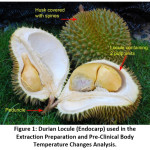 |
Figure 1: Durian Locule (Endocarp) used in the Extraction Preparation and Pre-Clinical Body Temperature Changes Analysis. |
Extraction of Pectin from Durian Rinds (Endocarp)
The dried durian endocarp rinds powder (50 g) of a different location (a [Tangkak], b [Muar] & c [Gopeng]) were stirred into a 450 ml hydrochloric acid aqueous solution which was adjusted to pH 2.5 (n = 3). The extraction was carried out at 85 °C for 60 minutes. The slurries were filtered through muslin cloth and allowed to cool to room temperature at 28 ± 0.2 oC. The acidified ethanol was prepared in which 4% hydrochloric acid were added in 95% ethanol in the ratio of 1:4 (v/v) and added into the extract (1:1 (v/v) ratio) and incubated for 60 mins at 28 ± 0.2 oC. The mixture was then were centrifuged at medium speed for 15 mins using benchtop centrifuge (Kubota 5100, Fujioka, Japan). The solutions were rewashed twice with 95% ethanol (1:2, v/v) and centrifuged for 15 mins. The precipitate was collected and dried in a hot-air oven at 60 °C for 24 hrs or until constant weight was achieved. The dried pectin were ground for further experiments. The durian endocarp rind pectin yield (%) collected was calculated as:
Pectin yield (%) = [Weight of dried pectin obtained/Initial weight of dried durian powder] x 100
Physicochemical Analysis
Locule Extract Density
An aqueous extraction method was used in accordance to Chansiripornchai et al. (2005) 9 with a slight modification. Three set of D24 durians were prepared (a, b & c) in accordance its different harvesting location. Each set of durian contained approximately 10 to 14 locules. The outermost skin of the locule was cut with a knife (endocarp). Then, the layer was ground with a blender (Panasonic Blender MX-801S, Japan) for 5 mins. After that, the powder of the layer was inserted into an empty tea bag or a tea strainer and then the tea bag was soaked into a beaker filled with 200 ml distilled water and next it was left for 5 mins 14,15. Then, the density of the locule extracted water was determined by using gravimetric scale 16,17. Approximately 10 ml of locule extracted water (pre-measured using micropipettes) was poured into a 100 ml beaker. The reading was taken at room temperature (28 ± 0.2 oC) for three replications (n = 3).
Determination of pH Value
The pH of the durian locule water immersion was measured according to Zubairi & Jaies (2014) 18. 200 ml locule extracted water was poured into a beaker. The pH values of the filtrate were measured using a digital pH meter (Model PB-10, Sartorius Basic Meter, Germany). The pH meter was calibrated using pH 4.0 and 7.0 buffer. The samples were stirred before measuring their pH values. The pH was adjusted using dilute NaOH and HCl solutions. The reading was taken at room temperature (28 ± 0.2 oC) for three replications (n = 3).
Immersed-Locule Water Temperature Changes
The distilled water was poured into an empty locule (endocarp) and it was left for 5 mins in at an ambient temperature of 28 ± 0.2 oC with 66% relative humidity (RH). The temperature of the distilled water was recorded every 20 seconds for 5 mins by using a digital thermometer. The procedure was repeated for three times (n = 3).
Pre-clinical Test
The pre-test as shown in Table 1 was conducted to determine the effects of cooling from the immersed-locule water on the respondents that drank it. After eating 200 g of D24 durian flesh (5 mins consumption time), each of the respondents had gone through three sets (Set A, Set B and Set C) of different procedures as below:
Table 1: Three Different Set of Body Temperature Changes Profiles for 5 Selected Respondents.
| Set | Methods* |
| A | The respondents ate the durian, but they did not have to drink the immersed-locule water or from the cup – CONTROL |
| B | The respondents ate the durian and they had to drink the immersed-locule water (500 ml) |
| C | The respondents ate the durian and they had to drink a cup of water (500 ml) |
Five respondents (R1, R2, R3, R4 & R5) were tested for 3 days. On the first day, the respondents had to undergo set A, where they were asked to eat the same amount of durian after their initial body temperature was recorded. Then, the changes in their body temperature were measured by using the oral digital thermometer. The reading of their body temperature was taken and recorded from each respondent simultaneously at the 30th, 60th, 90th, 120th, 150th, and 180th minute after they ate the durian. On the second day, the respondents went through set B where their initial body temperature was recorded. Then, the respondents were asked to eat the same amount of durian, and took a break for about 5 mins. After 5 mins, they had to drink the locule water. The reading of their body temperature was recorded by using the digital thermometer from each respondent simultaneously at the 30th, 60th, 90th, 120th, 150th, and 180th minute after they ate the durian and drank the extracted water. On the third day, the respondents were involved with set C, where the respondents’ initial body temperature was recorded and they had to eat the same amount of durian and took a break for about 5 mins. After that, they had to drink a cup of water (500 ml). The changes in their body temperature were recorded from each respondent simultaneously at the 30th, 60th, 90th, 120th, 150th, and 180th minute after they ate the durian and drank the water.
Statistical Analysis
The data was analysed in percentages as mean ± standard deviation values by repeating the procedures in the three replications. The standard deviation values were determined by using the one-way analysis of variance (ANOVA) and this was followed by Fisher’s Least Significant Difference to determine whether there was a significant difference between the samples. The significant value was based on the level of confidence, 95% (p<0.5). The statistical data was analysed by using the WPS Spreadsheet and visualised using graphs, and charts.
Results and Discussion
Exhaustive Pectin Yield
The exhaustive value of pectin content (%, w/w) derived from D24 durian rinds (endocarp) which were collected from 3 different location is shown in Table 2. All three places contained the same amount of pectin ranging from 66 to 72% (w/w) in dried endocarp rinds (p>0.05). Furthermore, the yield of pectin from orange peel, sweet lime, papaya powder and jackfruit waste were recorded ranging from 6.0% to 36.1%, 3.1% to 21%, 4.0% to 19.1% and 38.42% respectively 19,20. This shows that pectin obtained from D24 durian rinds (endocarp) give a higher amount of pectin due to its high amount of total carbohydrate (85%), crude fiber (27.81%) and cellulose (73.45%) 21.
Table 2: Characterization of D24 Durian Rinds (Endocarp) Pectin in Terms of Pectin Yield.
| Set | Location | Pectin Yield (%), w/w |
| (a) | Tangkak, Johor | 68.23 ± 2.22a |
| (b) | Muar, Johor | 69.14 ± 3.11a |
| (c) | Gopeng, Perak | 70.03 ± 3.44a |
Locule (Endocarp) Extract pH
In this study, the influence of the pH on the samples of locule (endocarp) extracts was shown in Fig. 2. Control sample A (distilled water had significantly (p<0.05) the highest pH value among all samples. Based on the results, the pH of the water was 7.22 (close to neutral), while the pH values for all three samples were below 7, which these were considered as acidic (low acid). The acidity is one of the physicochemical parameters that are responsible for a longer shelf-life of the products because certain degree of acidity protects the products from microorganisms 12.
![Figure 2: The pH Value of the Sample of the Locule Extracted Water and Distilled Water as the Control. Three Set of D24 Durians were Prepared (a [Tangkak], b [Muar] & c [Gopeng]). Each Set of Durian Contained 10 to 14 Locules. a-b: Different Letters Indicate a significant Difference at p<0.05.](http://www.foodandnutritionjournal.org/wp-content/uploads/2021/10/Vol9_No3_Ef_Dur_Sai_Fig2-150x150.jpg) |
Figure 2: The pH Value of the Sample of the Locule Extracted Water and Distilled Water as the Control. Three Set of D24 Durians were Prepared (a [Tangkak], b [Muar] & c [Gopeng]). Each Set of Durian Contained 10 to 14 Locules. a-b: Different Letters Indicate a significant Difference at p<0.05. |
Locule (Endocarp) Extract Density
Fig. 3 shows the density of the locule extracted water as compared to the control (distilled water). All samples had a significant difference (p<0.05) as compared to the control. The density of locule extracted water samples was higher than the distilled water due to other components availability in the extractive samples themselves (e.g. small dissolved/undissolved particulates and other minute constituents.
![Figure 3: Density of Locule Extracted Water Samples. Three Set of D24 Durians were prepared (a [Tangkak], b [Muar] & c [Gopeng]). Each Set of Durian Contained 10 to 14 Locules. a-b: Different Letters Indicate a Significant Difference at p<0.05.](http://www.foodandnutritionjournal.org/wp-content/uploads/2021/10/Vol9_No3_Ef_Dur_Sai_Fig31-150x150.jpg) |
Figure 3: Density of Locule Extracted Water Samples. Three Set of D24 Durians were prepared (a [Tangkak], b [Muar] & c [Gopeng]). Each Set of Durian Contained 10 to 14 Locules. a-b: Different Letters Indicate a Significant Difference at p<0.05. |
Temperature Changes of the Immersed-Locule Water
The distilled water was poured into the locule and the changes in the temperature were observed every 20 seconds for 5 mins. This test was done to determine the cooling effects prior to the pre-clinical of the immersed-locule water on human body temperature. From the observation, the temperature of 25.6 ± 0.2 oC remained constant for one and a half minute. Then, the temperature increased by around 1 °C and remained constant until it reached 5 mins. As a hypothesis, the temperature of water should slightly decrease due to the compounds available in the extract. On the contrary, there was no decrease in the temperature after 5 mins. Therefore, the temperature of the water did not contribute directly to the cooling process of the body temperature but instead could indirectly affect the cooling via homeostasis 17,22 which trigger by the compounds (e.g. pectin) abundantly available in from the skin of the locule (endocarp) as shown in Table 2.
Pre-Clinical Test
The pre-clinical test was performed to determine the changes in the respondents’ body temperature after they ate durian without drinking any water (Set A), after they ate the durian, they needed to drink some water in the durian locule (Set B), and they also needed to drink some water in a cup after they ate the durian (Set C). Therefore, this test was conducted to determine whether drinking water in a durian locule does help to lower the body temperature or not. The respondents’ initial body temperature was taken for every set of the test to determine any changes in their body temperature. Their body temperature was recorded every 30 mins for 3 hrs throughout the experiment.
The Figures (Fig. 4 to Fig. 8) shown are the data collected from 5 respondents of all sets, A, B and C. The respondents were given the same amount of durian and any changes in their body temperature were recorded. For the respondent R1, the body temperature increased rapidly from their initial temperature and it started to decrease after the 90th minute (set A). There were insignificant changes in the body temperature as compared to set B and C right after water consumption whether in the locule or from the cup (p>0.05). The body temperature seems to decrease rapidly after 30 mins and later maintaining the temperature towards the end of the observation. Unlike set A (without drinking water), there was a major increase right after the durian consumption as the heat sensation started to articulate profoundly as time went by.
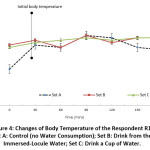 |
Figure 4: Changes of Body Temperature of the Respondent R1. Set A: Control (no Water Consumption); Set B: Drink from the Immersed-Locule Water; Set C: Drink a Cup of Water. |
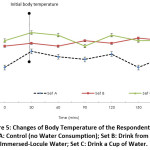 |
Figure 5: Changes of Body Temperature of the Respondent R2. Set A: Control (no Water Consumption); Set B: Drink from the Immersed-Locule Water; Set C: Drink a Cup of Water. |
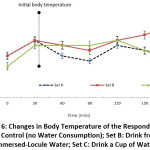 |
Figure 6: Changes in Body Temperature of the Respondent R3. Set A: Control (no Water Consumption); Set B: Drink from the Immersed-Locule Water; Set C: Drink a Cup of Water. |
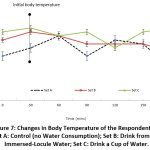 |
Figure 7: Changes in Body Temperature of the Respondent R4. Set A: Control (no Water Consumption); Set B: Drink from the Immersed-Locule Water; Set C: Drink a Cup of Water. |
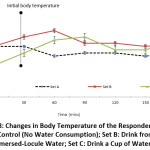 |
Figure 8: Changes in Body Temperature of the Respondent R5. Set A: Control (No Water Consumption); Set B: Drink from the Immersed-Locule Water; Set C: Drink a Cup of Water. |
For the respondent R2, the data did not differ much as in set A. The initial body temperature increased after 30 mins of eating durian flesh and started to decrease not long after 30 mins of treatment. However, the temperature trend of both Set B and C was maintained after drinking water in the cup and in the locule (p>0.05).
However, there was a different trend for the respondent R3 where the body temperature fluctuated for all sets. Set B body temperature was slightly increased from its initial temperature after eating durian and started to decrease after 30 mins of consumption (p<0.05) before spiking back at the 90th minute. However, Set C took a longer time to reduce the body temperature as it was considered as natural homeostasis effect to kick start into stabilization phase 17,19.
The R4 body temperature increased after eating the durian without drinking water (set A) and decreased after 60 mins (p<0.05). It increased again after 90 mins and plummeted sharply after 120th minute of observation (p<0.05). The set B body temperature was maintained until it decreased gradually at the 60th minute of observation (p<0.05). Unlike set B, set C remained consistent up to the 120th minute of observation (p>0.05) until it increases back towards the end of the treatment.
Finally, the R5 body temperature of set A maintained consistently towards the end of the treatment even though without drinking any water after eating durian (p>0.05). However, both set B and C body temperature increased slightly from its initial reading and gradually decreased to its initial temperature (before eating durian) at the 90th and 60th minute (p<0.05) to indicate the homeostasis condition attained.
Overall, the cooling effect from the immersed-durian locule water (B) was considered almost similar to the temperature profiles who took water from the cups (C) (p>0.05). The cooling effects were noticeably started to generate between 30 mins to 90 mins after treatment as the temperature were either maintained or slightly reduced. In fact, both water consumption profiles exhibit a consistent trend unlike the control profile that fluctuated throughout the treatment. The homeostasis mechanism might have been triggered naturally as the body senses a heaty sensation right after consuming durian flesh which is accompanied with the water intake to quench the heat. Moreover, the high amount of pectin/CMC in the durian rinds (endocarp) 12 which might be available in the locule water-immersion would possibly stabilized the heating sensation too as both mechanism seems to act simultaneously.
Conclusion
The “heaty” feeling that was felt after eating the durian was indeed due to the calories contained in the durian. For that reason, the locule water immersion was prepared to studies the efficacy of the concoction to reduce body heat. The basic physico-chemical properties revealed that the water extractive durian locule is considered a mild acidic concoction ranging from pH 6.5 to 6.8 with a density higher than the one of the distilled water. The high amount of pectin yield (>65%, w/w) indicate the bio-availability of the soluble fiber that might also presented in the locule water-immersion. As for the pre-clinical analysis, the oral body temperature profiles showed that the immersed-locule water exhibit a slight affect to the body temperature changes on a short period of time between 30 mins to 90 mins after treatment. The availability of pectin in the locule water-immersion might have help facilitates the natural homeostasis mechanism faster as to suppress of any sudden body heating after eating durian. However, the accuracy of this experiment might be influenced by several factors such as the respondents with higher metabolism were able to maintain their body temperature and digest the food faster than the others. Hence, the prevalence against different gender, age profiles and eating habit might exhibit a different perspectives as those parameters require more set of participation and advance analysis.
Acknowledgement
The authors acknowledge the Department of Food Sciences, Faculty of Science and Technology, UKM Bangi for supporting this project.
Funding Source
The reported study was funded by the Research University Grant (GUP-2018-057 and GUP-2018-080)
Data Availability Declaration
No data were used elsewhere to support this study and it was entirely a new set of data.
Conflicts of Interest Declaration
The authors declare that they have no conflicts of interest. The publication of this work in your journal is approved by all authors and we responsible that work was carried out, and, if accepted, it will not be published elsewhere including in English or in any other language, without the written consent of the copyright-holder.
References
- Kumolosasi E., Siew Gyn T., Mansor A. H., Makmor Bakry M., Azmi N., Jasamai M. Effects of durian intake on blood pressure and heart rate in healthy individuals. J. Food Prop. 2016; 19(7), 1483-1488. https://doi.org/10.1080/10942912.2015.1083577.
CrossRef - Arancibia-Avila P., Toledo F., Park Y. S., Jung S. T., Kang S. G., Heo B. G., Gorinstein, S. Antioxidant properties of durian fruit as influenced by ripening. LWT-Food Sci. Technol. 2008; 41(10), 2118-2125. DOI: 10.1016/j.lwt.2007.12.001.
CrossRef - Wanwimolruk S., Kanchanamayoon O., Boonpangrak S., Prachayasittikul V. Food safety in Thailand 1: it is safe to eat watermelon and durian in Thailand. Health Prev. 2015; 20(3), 204. DOI: 10.1007/s12199-015-0452-8.
CrossRef - Toledo F., Arancibia-Avila P., Park Y. S., Jung S. T., Kang S. G., Gu Heo B., Gorinstein S. Screening of the antioxidant and nutritional properties, phenolic contents and proteins of five durian cultivars. J. Food Sci. Nutr. 2008; 59(5), 415-427. DOI: 10.1080/09637480701603082.
CrossRef - Booncherm P., Siriphanich J. Postharvest physiology of durian pulp and husk. Kasetsart J. 1991; 25, 119-125.
- Haruenkit R., Poovarodom S., Leontowicz H., Leontowicz M., Sajewicz M., Kowalska T., Gorinstein S. Comparative study of health properties and nutritional value of durian, mangosteen, and snake fruit: experiments in vitro and in vivo. Agric. Food Chem.2007; 55(14), 5842-5849. DOI: 10.1021/jf070475a.
CrossRef - Manshor R. M., Anuar H., Nazri W., Busu W., Fitrie M. I. Preparation and characterization of physical properties of durian skin fibers biocomposite. Mat. Res.2012; 576, pp. 212-215. DOI:10.4028/www.scientific.net/AMR.576.212.
CrossRef - Wilaipon P. Durian husk properties and its heating value equation. J. Appl. Sci. 2011; 8(9), 893. DOI: https://doi.org/10.3844/ajassp.2011.893.896.
CrossRef - Chansiripornchai P., Pramatwinai C., Rungsipipat A., Ponsamart S., Nakchat O. The efficiency of polysaccharide gel extracted from fruit-hulls of durian (Durio zibethinus) for wound healing in pig skin. In III WOCMAP Congress on Medicinal and Aromatic Plants-Volume 5: Quality, Efficacy, Safety, Processing and Trade in Medicinal 679(pp. 37-43). Published in February 2003. Accessed on September 2019.
CrossRef - Futrakul B., Kanlayavattanakul M., Krisdaphong P. Biophysic evaluation of polysaccharide gel from durian’s fruit hulls for skin moisturizer. J. Cosmet. Sci.2010; 32(3), 211-215. DOI: 10.1111/j.1468-2494.2009.00552.x.
CrossRef - Ketsa S., Pangkool S. The effect of temperature and humidity on the ripening of durian fruits. J. Hortic. Sci.1995; 70(5), 827-831.
- Mondal M. I. H., Yeasmin M. S., Rahman M. S. Preparation of food grade carboxymethyl cellulose from corn husk agrowaste. J. Biol. Macromol. 2015; 79, 144-150. DOI: 10.1016/j.ijbiomac.2015.04.061.
CrossRef - Hoe V. B., Siong K. H. The nutritional value of indigenous fruits and vegetables in Sarawak. Asia Pac. J. Clin. Nutr. 1999; 8(1), 24-31. DOI: 10.1046/j.1440-6047.1999.00046.x.
CrossRef - Zubairi S. I., Wan Musa W. R., Mohammad S. A. F. S. Kajian Awalan Terhadap Penulenan Dan Pengenalpastian Asid Amino Aromatik L-Dopa Daripada Kaki Perekat Kupang Hijau Air Tawar Malaysia. Malaysian J. Anal. Sci. 2014; 18(2), 306-320.
- Zubairi S. I., Sarmidi M. R., Aziz R. A. The effects of raw material particles size, types of solvents and solvent-to-solid ratio on the yield of rotenone extracted from Derris elliptica. Sains Malays. 2014; 43(5), 707-713.
- Zubairi S. I., Sarmidi M. R., Aziz R. A. A preliminary study of rotenone exhaustive extraction kinetic from Derris elliptica dried roots using normal soaking extraction (NSE) method. Adv. Environ. Biol. 2014; 910-916.
- Aizad S., Khairiri N. M., Yahaya B. H., Zubairi S. I. A Novel Anti-Proliferative Activity (EC50) of Pegaga (Centella asiatica) Extract through In Vitro 3-D Culture Microenvironment. Teknol.2017; 79(2), 1-10. DOI: https://doi.org/10.11113/jt.v79.8566.
CrossRef - Zubairi S. I., Jaies N. S. Daun Hibiscus rosa sinensis: Analisis proksimat, aktiviti antioksidan dan kandungan bahan inorganik. Malaysian J. Anal. Sci. 2014; 18(2), 260-270.
- Yadav S.R., Khan Z. H., Kunjwani S. S., Mular S. M. Extraction and characterization of Pectin from different fruits. J. Appl. 2015; 1, 91-94.
- Sundarraj A. A., Ranganathan T. V., Gobikrishnan S. Optimized extraction and characterization of pectin from jackfruit (Artocarpus integer) wastes using response surface methodology. J. Biol. Macromol. 2017; 106, 698-703. DOI: 10.1016/j.ijbiomac.2017.08.065.
CrossRef - Ayora-Talavera T. D. R., Ramos-Chan C. A., Covarrubias-Cardenas A. G., Sanchez-Contreras A., Garcia-Cruz U., Pacheco N. A. L. Evaluation of pectin extraction conditions and polyphenol profile from Citrus x lantifolia Waste: potential applications as functional ingredients. 2017; 7, 28. https://doi.org/10.3390/agriculture7030028.
CrossRef - Kamalaldin N. A., Jaafar M., Zubairi S. I., Yahaya B. H. Physico-mechanical properties of HA/TCP pellets and their three-dimensional biological evaluation in vitro. In: Pham P. (eds) Tissue Engineering and Regenerative Medicine. Exp. Med. Biol. 2017; 1084, pp 1-15. DOI: 10.1007/5584_2017_130.
CrossRef

This work is licensed under a Creative Commons Attribution 4.0 International License.







